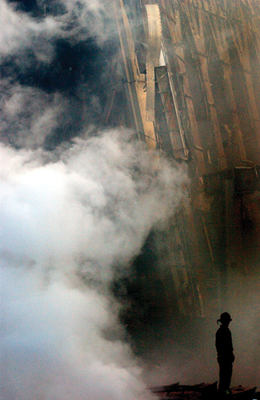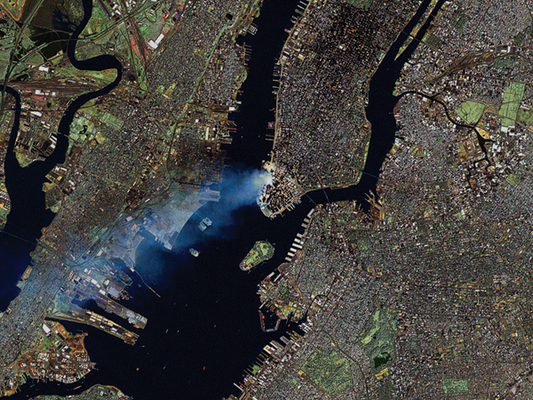
by Meg Marquardt Thursday, January 5, 2012

Beyond characterizing the minerals in the dust cloud, U.S. Geological Survey and NASA scientists helped identify long-burning fires beneath the rubble. U.S. Navy photo by Photographer's Mate 2nd Class Jim Watson

Satellite images taken by Landsat 7 after the attack show the smoke and dust plume across lower Manhattan. NASA
Five days after the Twin Towers collapsed, two geoscientists boarded a plane from Denver to New York City. They were part of a team that would use remote sensing techniques to categorize the hazards that might affect the rescue workers, civilians and survivors of the terrorist attacks. One of their immediate tasks involved identifying long-burning fires under the rubble. A second was to create a compositional profile of the debris cloud that resulted from the devastation. Part of the project was to be completed immediately using remote sensing, and part would take several months.
Over the course of two days, the researchers, Gregg Swayze and Todd Hoefen, both of the U.S. Geological Survey (USGS) in Denver, collected 38 samples of the dust that had blanketed lower Manhattan. Returning to their lab at USGS in Denver to analyze the samples, they would eventually classify the various components of the dust. Ten years later, the same samples are still in use, helping scientists determine if and how that dust may have caused longterm health problems for survivors and first responders.
As the dust began to settle following the attacks on the World Trade Center towers, an immediate concern was whether it contained amphibole asbestos, says Gregory Meeker, a geologist at the USGS Microbeam Laboratory in Denver. Researchers would not have been surprised to find the carcinogenic material highly concentrated in the debris, Meeker says, as it is commonly found in older building materials like ceiling tiles and certain types of industrial insulation. Inhalation of too much amphibole asbestos is associated with lung diseases such as mesothelioma. The concern was that if there were large amounts in the dust, first responders and even residents of lower Manhattan might have been inhaling toxic amounts.
The U.S. Environmental Protection Agency and the Public Health Service Commissioned Corps called in the USGS team because of the team’s expertise in categorizing dust and airborne contaminants, especially using remote sensing. Roger Clark, an astrophysicist in charge of the remote sensing work done at USGS, contacted his colleagues at NASA for the use of AVIRIS (Airborne Visible and Infra-Red Imaging Spectrometer), a remote sensing platform that had been used previously to identify pockets of asbestos in mining operations. AVIRIS was mounted on a plane flown by NASA pilots over lower Manhattan to map the dust and debris, while Swayze and Hoefen collected samples to calibrate the AVIRIS data.
Detailed characterization of the collected samples was used to help calibrate and interpret the AVIRIS remote sensing data, says Geoffrey Plumlee, a research geochemist at USGS in Denver. Once the data had been calibrated, Clark’s remote sensing team and NASA specialists began mapping the dust plume, identifying how various particles and minerals spread from Ground Zero.
In the lab, Meeker confirmed that Swayze and Hoefen’s dust samples contained very little amphibole asbestos. But other particulates — including chrysotile asbestos, gypsum and concrete dust — were present. It would still take some time to determine particle concentrations, however, and the full impact of this complex mix of particles on the human respiratory tract is unknown because it has still not been thoroughly investigated, Plumlee says.
Their work took on added urgency as concerns mounted: Within two days of beginning search and rescue operations, first responders, working tirelessly to find survivors and clear away debris, began to experience the onset of health complications. Some were forced to retreat because of severe coughing and increased difficulty breathing. Many kept going, despite the dangers.
Today, a question lingers: What did the dust cloud do to the lungs of those who rushed in to help?
Respiratory issues that stem from the inhalation of dust and minerals have been a concern of industries such as mining and animal ranching for decades. Particle inhalation has long been suspected of causing high rates of chronic obstructive pulmonary disease and pulmonary fibrosis, which involves scarring of the lungs, among workers. Most research has focused primarily on the effects of inhaling relatively small amounts of particles over a long time span. In the case of the World Trade Center collapse, however, civilians and first responders were exposed to extremely high particulate concentrations, albeit for relatively short durations. Thus, the health implications of their exposure were largely unknown. Additionally, millions of people came back to live and work in Manhattan soon after the attacks. The worry persisted that the dust might have settled inside buildings and homes, which could lead to widespread chronic health problems. That’s where the expertise of geoscientists became a crucial component in the investigation.
“As soon as they brought [the samples] back, we pretty much hit them with every analytical technique we had,” Meeker says. “We used cold chemistry, leach studies, electron microscopy and infrared spectroscopy” to determine what might exist in the dust.
Meeker and his team began to establish the dust’s mineral signature at various points around lower Manhattan. The dust’s signature — the proportion of each of the components — at different locations was important for health officials to track who was being exposed to what substances and in what amounts. Creating the signature was a difficult task, made more so by the fact that the dust covered many city blocks. In total, Swayze and Hoefen collected 38 samples at varying distances from Ground Zero, elevations and environments — indoor and outdoor — in those two days.
The USGS team found that the dust was mainly composed of gypsum (from drywall), concrete dust and vitreous human-made fibers such as those found in insulation products. Chrysotile asbestos accounted for 1 to 2 percent of the dust composition at most sites, Meeker says. The team also found traces of silica, titanium, zinc, lead and iron. But the variation in elemental distribution with distance and elevation was considerable. In a study published by USGS in 2005, Meeker reported that the gypsum content alone in the samples ranged from about 26 to 53 percent.
Once the USGS team had determined what was in the dust, the next task, Plumlee says, was to determine how it might affect people in the short and long term. That it had at least a shortterm impact had never really been in doubt. In 2006, the Centers for Disease Control and Prevention (CDC) studied 10,000 survivors who, at the time of the attack, were working or living in lower Manhattan buildings that were damaged or collapsed. More than half of the participants had “new or worsening respiratory symptoms” since 9/11, with symptoms ranging from sinus problems to wheezing to persistent cough. Most striking, the CDC reported, was that those workers and residents caught in the initial dust cloud were almost 67 percent more likely to have developed new symptoms, suggesting that even shortterm exposure to the debris was causing lasting health consequences. The study did not expound on the possible health implications for rescuers who had longer exposures to the dust cloud.
In 2009, Meeker was contacted by Dr. David Prezant, the chief medical officer at the Office of Medical Affairs for the New York City Fire Department. Prezant had obtained a sample of lung tissue from a firefighter who had received lung transplants due to a diagnosis of pulmonary fibrosis. The firefighter was a first responder, and there was a question about whether particles he inhaled at Ground Zero may have contributed to the disease. With the explanted lung tissue and the World Trade Center dust signature, Meeker and his team sought to determine if particles from the World Trade Center collapse had been present in the firefighter’s respiratory tract.
Meeker examined the lung tissue with a scanning electron microscope, which uses a highly focused electron beam to create high-resolution 3-D topographical images. Meeker also examined tissue from the hilar lymph node, a part of the immune system where foreign microbes and particles that find their way into the lungs accumulate.
“The short answer is that we didn’t find anything” like the World Trade Center dust, Meeker says. They did find that both types of tissue had an abundance of particles from clays, silica-rich particles, glasses and other minerals, he says, but there was no definitive proof that any of the mineral deposition could be attributed to World Trade Center debris. The result was not completely surprising, he adds: The major components of the World Trade Center dust — such as concrete powder and glass fibers — dissolve in the lungs over time. “Most glass fibers are actually designed to dissolve in the lungs fairly rapidly. So it’s not really surprising that years afterward, you wouldn’t find those materials in the same form as we saw them in the dust samples collected right after 9/11.”
Though the results were inconclusive, this was just the start of the study, Meeker says. As more lung samples become available, Meeker and Prezant will attempt to more conclusively determine if there is any link between health issues and World Trade Center dust.
As a result of the USGS team’s work on characterizing the dust, “we started realizing how we could be playing a more significant role in disaster response,” Plumlee says. Since 2001, USGS teams have responded to other disasters, such as Hurricane Katrina in 2005 and the California wildfires in 2007 and 2009. Going forward, USGS also hopes to develop a preemptive strategy, Plumlee says. “We can learn from what we found in past disasters and help apply that to what might happen in future disasters.”
Together with public health officials, earth scientists are creating models to describe how materials and chemicals — from damaged industrial factories or sewage plants, for example — might be affected by environmental catastrophes and what effect they could have on human health. The Great California Shakeout and the ARkStorm are two such attempts by the USGS and public health officials to model the effects of a large earthquake and widespread flooding, respectively, Plumlee notes. Geologic records show a history of large earthquakes along the San Andreas Fault, and written accounts describe the great floods that hit Southern California after a massive wave of storms in the 1860s. Given the historical precedence, it is possible that similar disasters may strike again — and possibly in the near future, he says.
The research can be applied to these types of natural disasters or to humanmade disasters such as the World Trade Center attack. “There is a very useful role that earth scientists can play in characterizing materials, understanding their sources, and then understanding how materials may change in the changing environment,” Plumlee says. “The more we know, the better we can understand if [materials] pose a long-term health risk” even before disaster strikes.
© 2008-2021. All rights reserved. Any copying, redistribution or retransmission of any of the contents of this service without the expressed written permission of the American Geosciences Institute is expressly prohibited. Click here for all copyright requests.